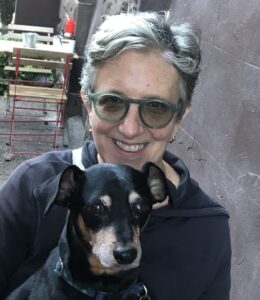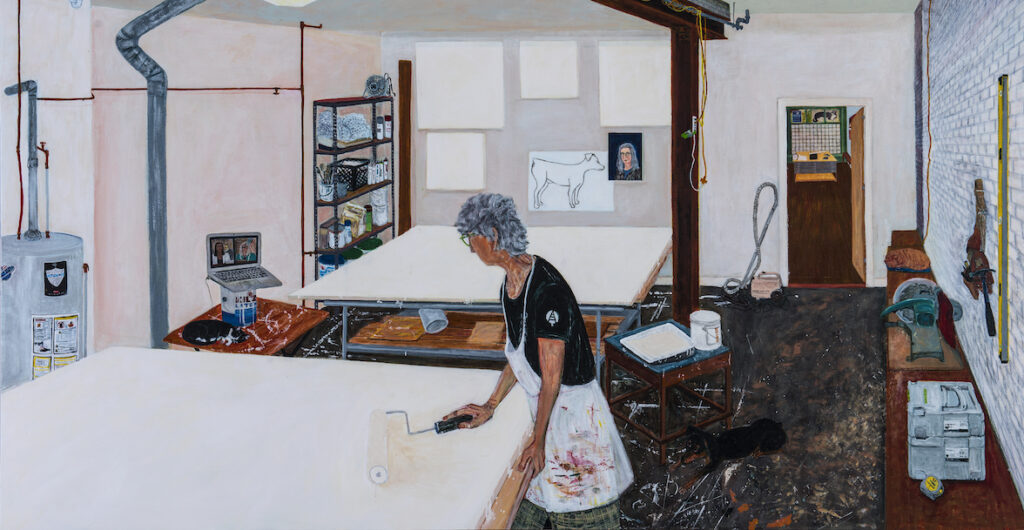Philadelphia-based painter Sarah McEneaney is known for her whimsical, autobiographical artworks that invite viewers to glimpse moments of her life, rooms within her Callowhill home, and aerial views of her neighborhood. Artist and writer Eileen Neff has described McEneaney’s work as “enlivened by the contradictory effects produced when romantic sensibility meets realist painting.”
McEneaney’s paintings are vulnerable, unpretentious, and easy to spend hours with. Viewers are rewarded when they do: an electrical outlet clipped onto a steel beam, a toolbelt hanging from a hook on a studio wall, and a Eureka Mighty Mite vacuum can be found in Panel Prep Hearing (2022). A self portrait, the painting captures McEneaney herself, preparing a large panel for future painting. As she primes the panel she watches the January 6 hearings on a laptop that she placed atop a paint can, on a wooden paint-splattered tray table, next to which a cat is curled up sleeping. [See above.]

McEneaney’s work can be seen in a host of prestigious institutions, including local ones such as the Philadelphia Museum of Art and the Pennsylvania Academy of Fine Arts (PAFA). Her community-based work in Philadelphia has also had significant impacts: she co-founded the Reading Viaduct Project in 2003, a project which merged with Friends of the Rail Park in 2013 and of which she is a board member to this day.
Paintings by McEneaney, including ones of the Rail Park, will be on view in two upcoming exhibitions: Rising Sun: Artists in an Uncertain America, March 23-October 8, 2023 at PAFA; and Shifting Ecologies: Contemporary Artists and the Environment, the opening exhibit of the new Maguire Museum at Saint Joseph’s University.
In partnership with the Forman Arts Initiative, The Citizen reached out to McEneaney to learn more about her artwork.
This interview has been edited and condensed.
Morgan Nitz: You moved to Philly for art school. Did you always intend to set down roots? If not, what made you stay?
Sarah McEneaney: Having grown up in the New York suburbs, I thought I’d go back to New York after college. But by the time I graduated from PAFA in 1979 I had come to love Philly [and its] art community. Plus, I bought the building where I have lived and worked for 44 years now!
You describe your work as autobiographical. How do you choose what to document in your paintings, and what to protect and keep private to yourself?
My paintings are autobiographical and narrative but they are heavily edited, embellished, and imagined. I have painted about traumatic events in my life: the early deaths of my parents, being raped, and surviving cancer. But there are always aspects I keep private. Even when I am doing a landscape or cityscape, the paintings are autobiographical. But I like to think that people read into the work the way they want, that they can enter and even change the story to suit them.
Your paintings strike a stunning balance between simplicity and vulnerability. When planning a painting, what’s on your mind? What catches your eye?
Sometimes an event or memory is the genesis of a painting or paintings. Sometimes it’s a fleeting image. I use drawings, observation, imagination, photographs — whatever I need to make the painting happen. The interiors involve more direct observation. For the exteriors I go out to the location (often a neighbor’s roof) and make drawings, color studies. Back in the studio I lay out the composition and begin painting. At some point I’ll take a snapshot of the work in progress, print it out and go back to the location and make notes for corrections and additions.
You have lived in Callowhill since the 1980’s. The neighborhood is a frequent subject of your paintings, and you have captured its transformation over the years. Do you see your work, in addition to being autobiographical, as a biography of the city in a way?
I’ve been here since 1979 and for almost 20 years there wasn’t much change — or, rather, change for the good. During the 80’s there was a lot of arson in the neighborhood. It was busy with commercial industry during the day but desolate and scary at night. I do see my work as a portrait of the neighborhood over a certain time period.
You have a background in carpentry and renovated your Callowhill home and studio yourself. How did you design the space to function both for living and artmaking?
I waited tables while a student but switched to carpentry for my second job when I bought my home/studio. I worked with and for other artists/carpenters to learn the trade. It was a great way to earn a living for a period of time and then [take time off to] be in the studio for the next month or so. I can’t claim sole credit for the design and build of my space, I was still learning at that time. It took about five years to get the whole space usable.
Do you have a favorite custom feature, or place in the home?
I love my garden. I realize it’s a precious space to have in my urban environment. This is evident in the painting, “Spring Summer 2019.” It depicts my interior (my yard is another room to me) and exterior worlds together.
Did your relationship to your home and studio change due to the pandemic?
The major change during the pandemic was that all my community work was happening via zoom rather than going out to meetings and events in person. Including art events — I have to say I loved being able to attend art talks via zoom all over the country and still do that.
You have long been involved in your community, with the Rail Park and the Callowhill Neighborhood Association? Why is it important for you, as an artist, to engage in community activism?
I am a founding member of Callowhill Neighborhood Association (2001) and currently serve as Board President. Since my high school days I have been politically engaged: from attending rallies and marches, canvassing or phone banking for candidates, serving on nonprofit boards, to volunteering for Planned Parenthood, Action Aids, ACT UP.
The more time I spent in my neighborhood, the more my work became locally focused. Think globally – act locally. When the residential portion of the neighborhood started to grow we became a new voting division and I gathered the poll workers to staff it. I served as Judge of Elections from 2009-2021. In 2021 I was appointed to the City Of Philadelphia Art Commission.
What advice would you have for someone who is interested in drawing/painting, but doesn’t think that they can learn, or doesn’t know where to start?
Take some classes! Fleisher Art Memorial and PAFA are two places that come quickly to mind. No matter your age or experience there’s something for everyone. And I’m sure there are many other places in different Philly neighborhoods .
Who are your favorite Philadelphia-based artists at the moment?
Leroy Johnson. I dearly miss him. He passed last summer but he and his vibrant work are on my mind all the time as I move through the city. I’d also like to mention two really interesting emerging painters whose work I’ve been following, Henry Murphy and Nasir Young.
Is there a project you’re working on that you’ve been excited about lately?
The original Barnes Museum is being repurposed as the Maguire Museum at Saint Joseph’s University. The Director, Emily Hage, is organizing the inaugural exhibition that focuses on environmental stewardship. Two of my Rail Park paintings will be in the show, Shifting Ecologies: Contemporary Artists and the Environment. My painting Clinic Defense, 1990, in PAFA’s collection will be featured in conjunction with PAFA’s upcoming exhibition, Rising Sun: Artists in an Uncertain America, which is a collaboration between PAFA and the African American Museum in Philadelphia. It will be on view in a gallery dedicated to providing contextual material and underscoring important themes about the state of American democracy, both past and present.
Last summer I was compelled to watch the January 6 hearings. I made 34 acrylic on paper portraits of the Committee members and witnesses, plus one that focuses on Liz Cheney and Cassie Hutchinson. I put the portraits on Instagram but would like to show them together somewhere so I’m thinking about that, maybe a small book.
Morgan Nitz (she/they) is a queer interdisciplinary artist and writer in Philly, and the . Their work has been shown at The Institute of Contemporary Art, Vox Populi, Pilot Projects, and other venues; they completed a residency at Jasper Studios; and were the co-inaugural curator of Straw, Tyler School of Art’s AV-closet-turned-Alumni-gallery. Follow them at morgannitz.com | @son_of_m.a.n

